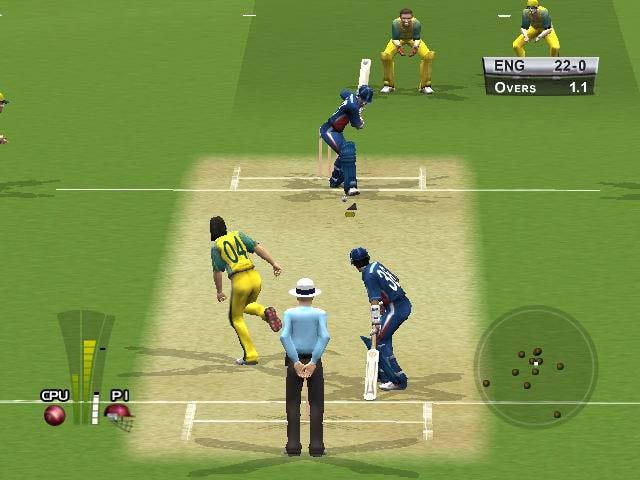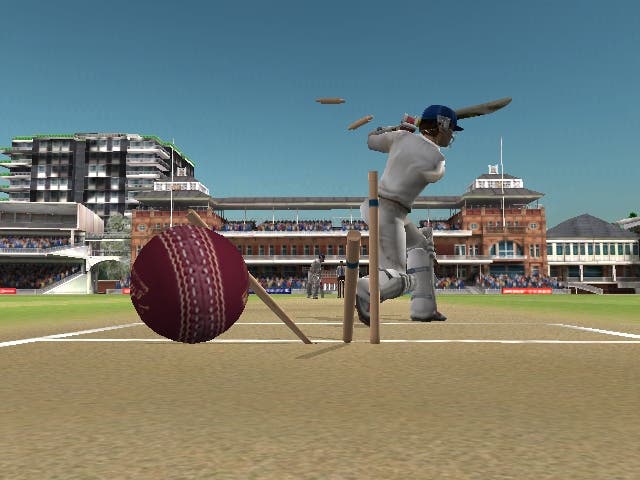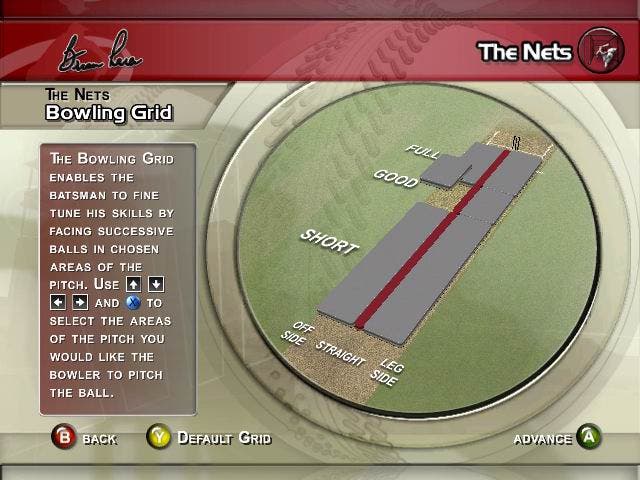Brian Lara International Cricket 2005
Bored of rain delays? This fills the time admirably.
The balance between attack and defence is always a difficult thing to get right in team games. In football, for example, you've got 11 players with different roles, but apart from a few tactical variations both teams are essentially competing for the same thing at the same time. Playing a team-based shooter like Counter-Strike is a similar equation; there's push and pull, but you can usually rely on consistency of personnel and technique.
To stick with CS, making cricket work as a game must be a bit like giving the Terrorists a stash of sub-machineguns and a lone Counter-Terrorist nothing but a riot shield - and telling him to defuse the bomb in-between being shot repeatedly and then having his bullets bounced back from all corners of the room. Imagine trying to balance that so both sides are having fun.
Swordfish Studios must be applauded, in which case, because Brian Lara International Cricket 2005 is decidedly entertaining and convincingly balanced - even if there are a few occasions when you feel like you're the bloke with the riot shield and someone just knifed you in the leg for good measure.
There's certainly little question that it does a better job than EA's latest Cricket title - arguably it's only convincing competition. That game's obscure and often inexplicable mechanics only seem to yield results after hours and hours spent groping around in the dark - and even then you realise that the actual logic and design is pretty daft anyway. Brian Lara starts off gratifying - with simple, convincing actions and results whether batting or bowling - and in the longer term demonstrates a degree of subtlety that gives you cause to keep slogging away contentedly.
Pick it up for a quick One Day International and you barely have to read the manual for more than five seconds to know the score. Going in to bat, you can play shots on the front or back foot or defend, and scoring runs is a question of judging the delivery in flight and then timing your shot and directing it with the analogue stick. Defend a few successfully and your confidence builds up and boundaries become a more realistic prospect. On the lower difficulties it's just a case of positioning yourself to sweep the ball impressively to wherever the field is weakest.
As you start to get better at building up to big strokes, you can afford to move up to a higher difficulty level where the need for strategy becomes more intense and the opposition more creative. By the end, your tactics will make sense and you can even reposition the field yourself to get what you want out of a bowling attack.

Switch roles and you'll find bowling quite comfortable but breakthroughs difficult. But, again, unlike EA's Cricket effort the breakthroughs make sense when they come on the end of variation and building up bowler skill in a manner similar to batting. After a few solid deliveries you can throw a Yorker or Googly and hopefully reap the rewards. Lazily toss the ball down an obvious line again and again and the batsmen will wise up and bash you around all corners of the park - and they certainly become more aggressive the further you get into an innings, so without due consideration the score can run away with itself.
And whereas Cricket 2005 felt random in terms of its difficulty curve, with incredibly unlikely tactics reaping unjust rewards, Brian Lara never strays too far from what you might expect. You won't be able to win by using a crap bowler to lull a series of top-order batsmen to loft the ball to the exact same fielder, for example.
Heck, even if you could, you'd have to work to catch the ball. Whereas Cricket 2005 was (surprise, surprise) a bit random in that respect, in Brian Lara you watch the ball through the air and then have a split-second to pause a cursor halfway along a sort of "catch meter". The same thing applies when picking up the ball to throw it to stumps - land the cursor in the sweet spot and the throw's much quicker and more accurate, putting the sprinting batsman's integrity in much greater peril. It adds a bit of adrenaline to the game of a sport that only serves up adrenaline in small doses anyway.
You don't get run out all the time, either. Not least because deciding not to run a couple of feet up the wicket isn't a recipe for disaster; the throws come in at a believable rate and frantically cancelling the run works. Of course you still do get run out, just as you still get bowled because you're being cocky, or you play it short and get caught because you're just lazily trying to swoop it over square leg for a boundary - but your failure is far more a measure of your skill than it is in any other current cricket title.

Admittedly there are still problems. It seems a shame that you can't throw the ball directly at the stumps - it's perhaps trite for reviewers to suggest a better way, but we imagined it might be fun to risk the direct shot by holding a shoulder button or something. As it is, all your throwing simply sends the ball to the wicket keeper. And just to prove that we did mean to say "batsman" and not "batsmen" a couple of paragraphs ago, you can't actually throw it to the bowler's end, which is disappointing.
There are also what you might call a few missing animations. On the whole the game does a good enough job visually, with some lovely animations for bowling actions - including different approaches for the classic matches, which is a nice touch - as well as a variety of catches, throwing animations and batting strokes. But there are plenty of occasions when the chap stops the ball at the boundary, picks it up and looks like he's about to throw it through the camera directly at you; instead sending it back to the middle somewhat unconvincingly. Likewise, if you bowl a wide bouncer and it makes it past the wicket keeper, the slip fielder next to him stands there completely unmoved even as his nearest pal rockets after it. There's also a lot of unconvincing blending of animations, similar to the way the ball seems to snap to someone's boot in a football game.
But really the biggest issue for this reviewer was the gulf in difficulty between "Village" and "County", what you might call the "Normal" and "Hard" difficulty levels. There's another difficulty level in either direction, but these are probably the two you'll experience most - and the difference can be quite jarring. With a bit more explanation in-game, the transition could have been a little gentler. Feeling it out will be fine for some but not others. You certainly don't want to spend all your time working at the lower levels, because there are some patterns of play there that can be endlessly and rather tediously exploited; batting on Village difficulty level, for example, makes it incredibly easy to move to one side of the crease and block most of the wicket and then just blast the ball out for six far more often than makes sense. Even if it does look great when you do.

Fortunately most of what's questionable about Brian Lara International Cricket can be forgiven because it has enough strength elsewhere. EA has all the money, so most of the names aren't accurate - although those involved in ICC competitions, which are licensed, do appear - and there are some daft presentational issues like website URLs appearing on ad-hoardings in late-1900s classic scenario matches. But then, er, it's nice that there are classic scenario matches in the first place! These are great fun, acting as a sort of narrative mode that not only lets you assume roles on both sides of famous cricketing scenarios, draping them in a crackly black-and-white visual filter for effect, but also teach you a bit about the origins of famous Test Series and rule changes.
You've also got the official cricket tournaments, a wealth of trophies to unlock on higher levels, and lots of match-length options - including Double Wicket, which involves picking two players each and then playing with a points system rather than traditional wickets, runs and overs.
It may not be perfect, then, but whereas EA Cricket 2005 was less predictable than the English weather in July, this Brian Lara effort is varied and entertaining without forcing you to sit there feeling like your head's number than your backside and that you've wasted your time turning up at all. It has its problems, but it's the most entertaining approximation of the sport we've come across on these systems, and well worth considering if you're in the market for a cricket game. With a bit more polish, next year's version may set an even bigger total.








